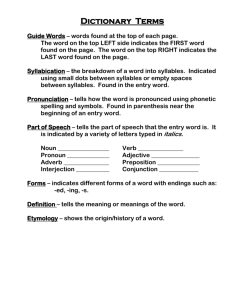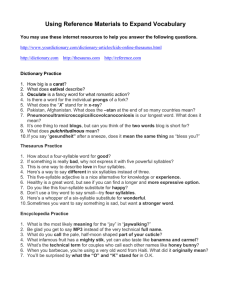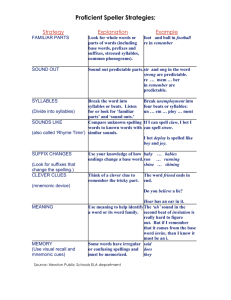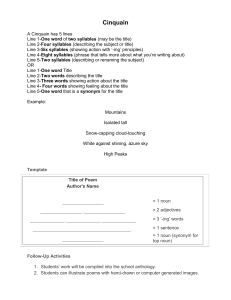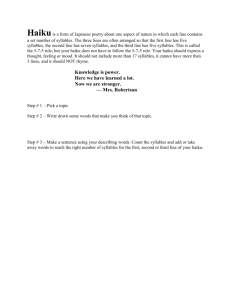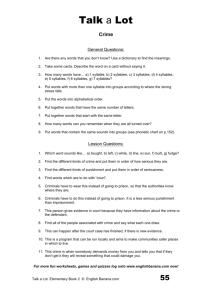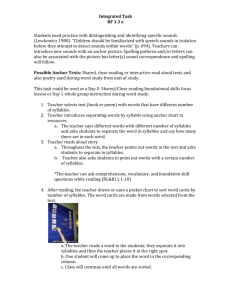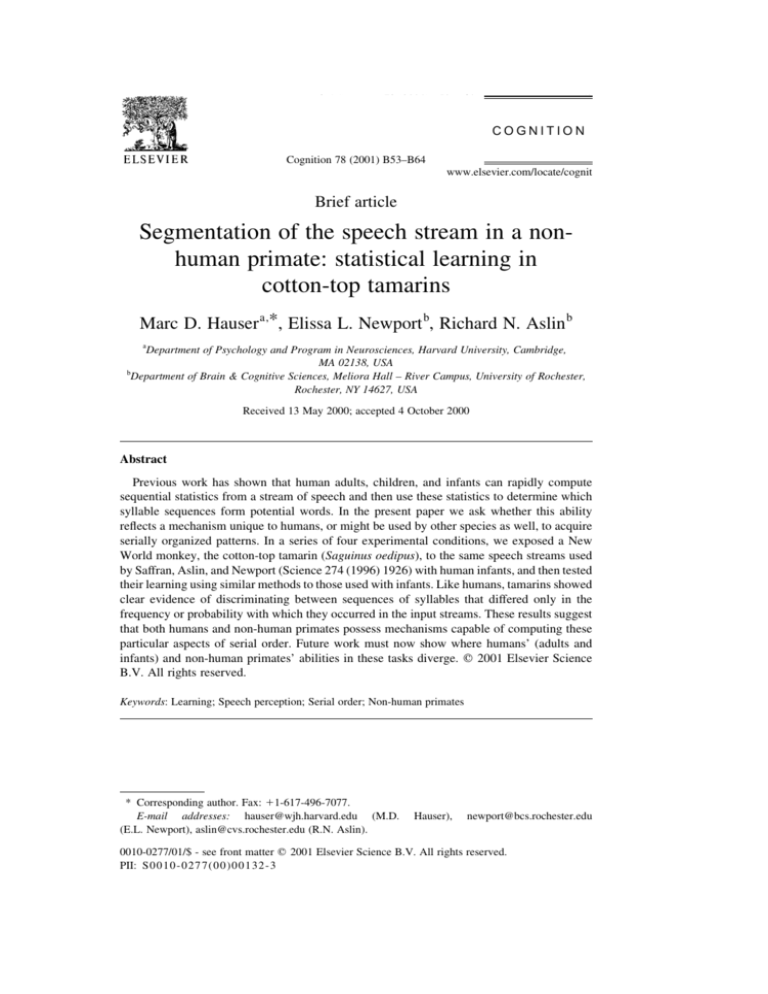
M.D. Hauser et al. / Cognition 78 (2001) B53±B64
B53
COGNITION
Cognition 78 (2001) B53±B64
www.elsevier.com/locate/cognit
Brief article
Segmentation of the speech stream in a nonhuman primate: statistical learning in
cotton-top tamarins
Marc D. Hauser a,*, Elissa L. Newport b, Richard N. Aslin b
a
Department of Psychology and Program in Neurosciences, Harvard University, Cambridge,
MA 02138, USA
b
Department of Brain & Cognitive Sciences, Meliora Hall ± River Campus, University of Rochester,
Rochester, NY 14627, USA
Received 13 May 2000; accepted 4 October 2000
Abstract
Previous work has shown that human adults, children, and infants can rapidly compute
sequential statistics from a stream of speech and then use these statistics to determine which
syllable sequences form potential words. In the present paper we ask whether this ability
re¯ects a mechanism unique to humans, or might be used by other species as well, to acquire
serially organized patterns. In a series of four experimental conditions, we exposed a New
World monkey, the cotton-top tamarin (Saguinus oedipus), to the same speech streams used
by Saffran, Aslin, and Newport (Science 274 (1996) 1926) with human infants, and then tested
their learning using similar methods to those used with infants. Like humans, tamarins showed
clear evidence of discriminating between sequences of syllables that differed only in the
frequency or probability with which they occurred in the input streams. These results suggest
that both humans and non-human primates possess mechanisms capable of computing these
particular aspects of serial order. Future work must now show where humans' (adults and
infants) and non-human primates' abilities in these tasks diverge. q 2001 Elsevier Science
B.V. All rights reserved.
Keywords: Learning; Speech perception; Serial order; Non-human primates
* Corresponding author. Fax: 11-617-496-7077.
E-mail addresses: hauser@wjh.harvard.edu (M.D.
(E.L. Newport), aslin@cvs.rochester.edu (R.N. Aslin).
Hauser),
newport@bcs.rochester.edu
0010-0277/01/$ - see front matter q 2001 Elsevier Science B.V. All rights reserved.
PII: S 0010-027 7(00)00132-3
B54
M.D. Hauser et al. / Cognition 78 (2001) B53±B64
1. Introduction
Humans have remarkable serial order abilities, demonstrated most clearly by their
aptitude for acquiring natural languages. In a series of recent studies we have begun
to investigate these abilities experimentally, by designing miniature languages
which contain particular serial order properties exempli®ed in natural languages,
and then asking whether, and how, human adults, children and infants acquire these
properties from brief exposure to the languages. In the present studies we ask
whether a non-human primate, the cotton-top tamarin monkey, can perform the
most basic of these learning tasks on the same sequences of human speech.
1.1. Word segmentation
A fundamental ability that human language learners must possess is the ability to
keep track of the order in which elements of the sound stream occur. One learning
problem in which this ability might be used is word segmentation ± the process of
determining which sequences of sounds in the stream of speech form words. While
native speakers of a language perceive breaks between the words within an utterance, acoustic analyses reveal that there are no physical cues, such as silence, which
reliably signal the end of one word and the beginning of another (Cole & Jakimik,
1980). However, one way of identifying words in an unknown language is to ®nd the
recurring sequences of sounds in a corpus of speech (Chomsky, 1955/1975; Harris,
1951). Those sound sequences that occur repeatedly (e.g. happy or children) are
candidates for words, while those that occur only occasionally (e.g. the sequence
pychil, when these words occur together) are likely to be the accidental juxtapositions at word boundaries. To determine which sound sequences in a stream of speech
form words, learners might compute the conditional probabilities between sequential syllables, called transitional probabilities 1 (Christophe, Dupoux, Bertoncini, &
Mehler, 1994; Goodsitt, Morgan, & Kuhl, 1993; Miller & Selfridge, 1950; Saffran,
Newport, & Aslin, 1996). Over a speech corpus, syllable sequences with relatively
high transitional probabilities are likely to be inside words, while those with relatively low probabilities are likely to be at the word boundaries.
Until recently, it has seemed implausible to imagine that human language learners
could conduct such an analysis on-line. Although several studies have shown that
infants can learn the order of events (e.g. Bauer & Mandler, 1989; Mandel, Kemler
Nelson, & Jusczyk, 1996; Trehub, Thorpe, & Morrongiello, 1987), none have asked
whether they can compute more complex order statistics. But, following a study by
Hayes and Clark (1970), recent studies have shown that human learners (as young as
1
Technically, our studies have asked whether subjects compute either the frequency of co-occurrence
of syllables or some conditionalized probability of such syllable co-occurrences. In one study (Aslin et al.,
1998), we demonstrated that infants do not merely compute co-occurrence frequency, but rather compute
conditionalized probability. But in all cases our results are compatible with a number of conditionalized
statistics, such as conditional entropy or mutual information, as well as with transitional probability. We
cite the notion `transitional probability' in our papers because of its venerable history in psycholinguistics,
but we use this term as a reference to a class of conditionalized statistics.
M.D. Hauser et al. / Cognition 78 (2001) B53±B64
B55
8-month-old infants) are capable of keeping track of such sequential statistics in
rapidly presented auditory materials (Aslin, Saffran, & Newport, 1998; Saffran,
Aslin, & Newport, 1996; Saffran, Newport, & Aslin, 1996; Saffran, Newport,
Aslin, Tunick, & Barrueco, 1997). In these studies, subjects were presented with
a stream of speech, composed of a random ordering of trisyllabic nonsense `words'
from an arti®cial language. There were no acoustic cues to word boundaries; words
were speci®ed only by the statistics of the syllable sequences. Adults, children, and
infants exposed to such streams discriminated the words (sequences with relatively
high transitional probabilities) from sequences that had occurred in the familiarization stream with low transitional probabilities. Human learners are also capable of
using statistical cues to segment non-speech input, such as musical tones (Saffran,
Johnson, Aslin, & Newport, 1999), visual patterns (Asaad, 1998; Fiser & Aslin,
2000), and visuomotor sequences (Hunt & Aslin, 1998). In short, human learners are
readily able to acquire the statistics of sequential patterns across a number of
modalities and domains.
1.2. Sequential abilities in non-humans
Since humans can compute such statistics across a wide range of patterned materials, it is of interest to ask whether non-human animals can perform such basic
computations on at least some of the same materials. Studies of natural vocal
communication systems, as well as operant studies of serial learning, suggest that
both birds and primates may have some clear, though limited, sequential abilities.
For example, chickadees, zebra ®nches, and a number of other oscine species
produce the notes and syllables of their songs in a ®xed or stereotyped sequence,
with order playing a crucial role in species, dialect, and individual identity (Hailman
& Ficken, 1987; Hailman, Ficken, & Ficken, 1985, 1987; Immelman, 1969; Marler,
1977, 2000; Price, 1979). For some oscines (e.g. zebra ®nches), the particular
syllables produced and the order in which they are sung is acquired from hearing
the father's song. 2 Tamarins, titi monkeys, and capuchins (Cleveland & Snowdon,
1981; Robinson, 1979, 1984) sometimes combine discrete call types into a sequence
that results in a new call type. However, the acoustic structure of most non-human
primate vocal repertoires appears to be relatively ®xed at birth, with auditory experience playing only a minimal role in shaping call morphology (cf. Seyfarth &
Cheney, 1999, for a review). Operant conditioning studies have shown that pigeons,
capuchin monkeys, and rhesus macaques can learn arbitrary serial lists of up to six or
so visually or auditorily presented items through training (D'Amato & Colombo,
1989; Schwartz, Chen, & Terrace, 1990; Terrace, 1987, 1991; Wright & Rivera,
1997). It has also been suggested that human-reared bonobos can perceive spoken
words and can respond correctly to word order (Savage-Rumbaugh et al., 1993).
While these studies provide evidence of some serial order abilities in non-human
2
For the present purposes we focus only on the issue of sequence and leave aside the question of
whether varying sequences occur and have new combinatorial meanings. See Hauser (2000) for discussion.
B56
M.D. Hauser et al. / Cognition 78 (2001) B53±B64
species, many patterned domains (such as language and music) require serial order
processing that is more complex than learning ®xed sequences. In such domains,
learners must keep track of relative serial order among pattern elements, and also the
frequency or consistency with which various combinations and orders appear.
Human learners are apparently capable of performing such computations on a
large number of syllable sequences simultaneously, extremely rapidly as speech
occurs in real time, and without training or reinforcement.
In the present studies we explore the species generality of these more complex
serial order abilities to determine whether rapid statistical serial order learning is
spontaneously present in tamarin monkeys ± a species whose own vocalizations
have some rudimentary sequential structure (Cleveland & Snowdon, 1981; Weiss
& Hauser, unpublished data). To ensure that the abilities in question are comparable
to those evaluated in humans, we ask whether tamarins can perform the same task on
the same sequences of speech syllables that we presented to human infants, and
tested with the same general methods.
2. Method
2.1. Subjects
Subjects were 13 adult cotton-top tamarins (Saguinus oedipus), seven females and
six males. This species is native to the rainforests of Colombia. All subjects were
born in captivity at the New England Regional Primate Research Center, Southborough, MA and have been housed at the Primate Cognitive Neuroscience Lab,
Harvard University for approximately 8 years. Animals are housed in social groups
consisting of a mating pair, and in some cases, their offspring. Tamarins' frequency
sensitivity includes the range of human speech sounds (Cleveland & Snowdon,
1981; Stebbins, 1983).
All subjects have experience in playback experiments (Garibaldi, 1999; Ramus,
Hauser, Miller, Morris, & Mehler, 2000; Weiss, Garibaldi, & Hauser, in press) and
in experiments involving other cognitive abilities (Hauser, 1997, 1998; Santos &
Hauser, 1999). Because of this, subjects voluntarily move in and out of their home
cage and into a test area. When they arrive in the testing area, they are calm and will
typically remain so for approximately 30 min. We can therefore present stimuli over
a relatively long period of time without distressing them. All 13 subjects were tested
in each of four conditions, but not all 13 provided useable data (see below).
2.2. Stimuli
Stimuli consisted of two of the same streams of synthetic speech syllables used in
the human infant studies of Saffran, Aslin, and Newport (1996). The ®rst speech
stream (Language A) consisted of a 20 min random ordering of four three-syllable
nonsense words (tupiro, golabu, bidaku, and padoti). The second speech stream
(Language B) consisted of a similarly structured stream of four different words
(tudaro, pigola, bikuti, and budopa). For both streams, the rate of presentation
M.D. Hauser et al. / Cognition 78 (2001) B53±B64
B57
was 4.5 syllables/s, with no acoustic cues at word boundaries. The only available
information for extracting words was the greater statistical regularity of syllable
sequences within words than of syllable sequences that spanned a word boundary.
The coherence of syllables within words was tested against the reduced coherence of
syllables within one of two types of foils: non-words, which contained syllables in an
order that never occurred in the speech stream, or part-words, which contained
syllables spanning a word boundary.
Two types of statistical cues differentiated words from part-words or non-words:
the transitional probabilities between adjacent syllables, and the frequency of cooccurrence of adjacent syllables. Within the 20 min stream of speech, each of the
four trisyllabic nonsense words occurred equally often and in random order, with the
constraint that no word was immediately repeated. The transitional probabilities 3 for
syllables inside words were thus 1.0 (between syllables 1 and 2) and 1.0 (between
syllables 2 and 3), the transitional probabilities for syllables within part-words were
0.33 (between syllable 3 of one word and syllable 1 of the next) and 1.0 (between
syllable 1 and 2 of a word), and the transitional probabilities for syllables within
non-words were 0.0 and 0.0. The words, part-words, and non-words also differed in
the frequency with which these syllable sequences occurred in the exposure stream. 4
Each of the words occurred three times more frequently than each of the part-words;
each of the non-words never occurred in the stream. Thus, both transitional probabilities and trisyllabic co-occurrence frequencies differed between the words and
the part- or non-words. In either case, in order to discriminate between the test items,
subjects would have to compute complex statistics involving the frequency or
consistency with which syllables occur in a particular relative order. Test items
did not differ in the frequency of individual syllables.
2.3. Design
Because of the small number of available tamarins, a within-subject design was
employed in which all of the tamarins were presented with two different speech
streams, each tested on two different sets of test item contrasts, over four separate 2
day familiarization±test sessions. The ®rst session consisted of Language A and the
word (tupiro, golabu) versus non-word (dapiku, tilado) test. The second session,
conducted 1 week later, consisted of Language A and the word (tupiro, golabu)
versus part-word (tibida, kupado) test. The third session, conducted 7 weeks later,
consisted of Language B and the word (tudaro, pigola) versus part-word (pabiku,
tibudo) test. The ®nal session, run 1 week later, consisted of Language B and the
word (tudaro, pigola) versus non-word (tigobu, kudabi) test. This design (see Table
1) ensured that differential responding to the words versus non- or part-words could
not result from intrinsic preferences for certain test items, because the words, nonwords, and part-words in Languages A and B were different syllable sequences.
3
[P(y|x) P(xy)/P(x)].
See Aslin et al. (1998) for a paradigm used with infants in which only transitional probabilities
differed between the test items, and co-occurrence frequency was matched.
4
B58
M.D. Hauser et al. / Cognition 78 (2001) B53±B64
Table 1
Design of Languages A and B and test items comparing words versus non-words or words versus partwords
Words
Test words
Test non-words
Test part-words
Language A
Language B
tupiro, golabu, bidaku, padoti
tupiro, golabu
dapiku, tilado
tibida, kupado
tudaro, pigola, bikuti, budopa
tudaro, pigola
tigobu, kudabi
pabiku, tibudo
Moreover, the order of the conditions across the four sessions ensured that performance on session 1 (Language A, non-words) and session 3 (Language B, partwords) was uncontaminated by previous exposure to the test items. 5
2.4. Experimental procedure
Each of the four test sessions involved the same 2 day familiarization±test procedure, and differed only in the stimuli presented for familiarization and test. On day 1,
the entire colony of tamarins was familiarized to a 20 min continuous speech stream,
while housed in their home room. On day 2, each tamarin was placed individually in
the sound proof chamber (Fig. 1A) and re-familiarized with a 1 min corpus of the
speech stream, followed immediately by four test trials, in random order: single
instances of two words and two non-words, or two words and two part-words. The
mean inter-trial interval for test trials was 23.1 s (SD 10.5). We did not run subjects
who failed to leave their home room cage on the day of testing, or those who jumped
around the test cage and failed to sit quietly (three in session 3, four in session 4).
The dependent measure was an orienting response to a test stimulus presented from a
concealed loudspeaker. For clarity in scoring a response, stimuli were presented
when the subject was still and facing 1808 away from the concealed speaker (that is,
looking down and away from the speaker; Ramus et al., 2000). Subjects were scored
as responding if they turned and looked in the direction of the speaker either during
the presentation of the test stimulus, or within 2 s afterwards. Fig. 1B presents an
example of a test trial and an orienting response following stimulus presentation.
Orienting responses were scored independently by two observers from digitized
video recordings; the observers were blind to the test condition (the inter-observer
reliability was 82±92%). Trials on which subjects were not facing away from the
speaker at stimulus onset, or on which observers could not code a response unambiguously, were eliminated (6%). This procedure has been used reliably in other
experiments (Garibaldi, 1999; Ramus et al., 2000; Weiss et al., in press).
5
Since the same words are used as test items for the part-word and the non-word test sessions, it is
possible that a novelty effect for the part-word/non-word on the second test session for a given language
could result from having already been tested with the words in the previous session. To test for this effect,
we ran the word/non-word contrast ®rst in Language A and the word/part-word contrast ®rst in Language
B. No difference appeared between the ®rst and second use of the same words in this design, and both ®rst
sessions showed a signi®cant discrimination.
M.D. Hauser et al. / Cognition 78 (2001) B53±B64
B59
Fig. 1. (A) Experimental set-up for running cotton-top tamarins. (B) Frame-by-frame illustration of a
tamarin's behavior during a playback trial.
B60
M.D. Hauser et al. / Cognition 78 (2001) B53±B64
3. Results
Each animal's responses in each test condition (words versus non- or part-words)
were converted to a proportion, and these proportions were averaged across animals.
Fig. 2 presents the mean proportion of trials showing an orienting response to words
versus non-words. Non-words consisted of three syllables from the language in an
order that had never occurred in the familiarization corpus. This contrast thus
assesses subjects' learning of syllable order. As can be seen, the tamarins were
signi®cantly more likely to orient to non-words than to words (Wilcoxon Signed
Ranks: z
13 2:45, P 0:01 for Language A; z
9 1:54, P 0:12 for Language
B; z
13 2:67, P , 0:01 for A and B combined across each animal's useable test
trials). Words and non-words were matched in the frequency of each of the individual syllables, and differed only in the order in which these syllables occurred. This
discrimination therefore shows that tamarins acquired syllable order from their
exposure to the speech streams, a result that parallels those obtained by Saffran,
Aslin, and Newport (1996) with human infants.
Fig. 3 presents the mean proportion of trials showing an orienting response to
words versus part-words. Part-words consist of the ®nal syllable of one word and the
®rst two syllables of another word; part-words are therefore sequences which did
occur in the corpus. Comparing subjects' responses to words versus part-words
assesses their learning of the frequency or probability with which various syllable
orders occurred. Tamarins were signi®cantly more likely to orient to part-words than
to words (Wilcoxon Signed Ranks: z
13 2:93, P 0:003 for Language A;
Fig. 2. Mean (standard error) percent of word versus nonword test trials on which subjects responded, for
Language A (left) and Language B (right). Black bars indicate responses to word trials, cross-hatched bars
indicate responses to nonword trials.
M.D. Hauser et al. / Cognition 78 (2001) B53±B64
B61
Fig. 3. Mean (standard error) percent of word versus partword test trials on which subjects responded, for
Language A (left) and Language B (right). Black bars indicate responses to word trials, stippled bars
indicate responses to partword trials.
z
10 2:24, P 0:025 for Language B; z
13 2:93, P 0:003 for A and B
combined across each animal's useable test trials).
These results show much more complex serial order learning than the word/nonword contrast, and again parallel the ®ndings of Saffran, Aslin, and Newport (1996)
for human infants. Since words and part-words differ only in the transitional probability (or co-occurrence frequency) of one syllable pair within the trisyllabic unit,
successful discrimination shows that tamarins, like human infants, are computing
fairly complex serial order statistics during presentation of the familiarization corpus,
and that they are performing these computations rapidly, reasonably accurately over a
large number of syllable pairs, and without training or reinforcement for doing so.
Although the overall results for non-words and for part-words across the two
languages were signi®cant, the key data come from Language A (non-words) and
Language B (part-words). These two conditions, which both showed signi®cant
evidence of discrimination between the two types of test items, could not have
resulted from the tamarins' previous exposure to the speci®c test items (which
was possible for Language A, part-words and Language B, non-words).
4. Discussion
Our results show that tamarin monkeys ± a species known to produce their natural
calls with some ®xed order properties and to perceive certain contrasts in natural
human speech (Garibaldi, 1999; Ramus et al., 2000; Weiss et al., in press) ± are
B62
M.D. Hauser et al. / Cognition 78 (2001) B53±B64
capable of computing the same rather complex statistical regularities on ¯uent and
rapid streams of synthetic human speech that have been demonstrated, by similar
methods, in human infants (Saffran, Aslin, & Newport, 1996). These discriminations
entail a number of separate abilities worthy of note.
First, to perform this task successfully, tamarins must be capable of discriminating speech syllables from one another, and treating these syllables (or the phonemes
of which they are composed) as elementary units. Second, they must be capable of
keeping track of the serial order in which these syllables occur, as well as the
frequency and/or transitional probability of each syllable pair or syllable triplet
computed over a sizeable sample of the rapid speech stream. 6 Moreover, tamarins,
like human infants, must be capable of performing such computations rapidly and
without training or reinforcement.
These results suggest that humans and tamarins may share a common mechanism
for rapidly processing and retaining these aspects of serial order information.
However, even if humans and some non-human primates share the ability to
compute certain elementary patterns of serial order, these abilities in humans (at
least for the domain of language) have been extended and elaborated well beyond
what we have demonstrated in the present tasks, into complexities of serial order
processing that we do not expect non-human primates to share. The type of statistical computation examined here (computing co-occurrence relations between
immediately adjacent elements) is a fundamental aspect of serial learning, potentially important to providing learners with an initial segmentation of speech or many
other types of patterned domains (Newport & Aslin, 2000; Saffran et al., 1999).
However, such an analysis would not be adequate for acquiring higher level patterns
in language; many structures in natural languages involve relationships between
classes of elements, or relations between elements not immediately adjacent to
each other (cf. Chomsky, 1957). This suggests that some computational mechanisms
beyond those studied here may be speci®c to humans and absent or de®cient in
monkeys, since only humans show the full range of linguistic skills that characterize
natural language systems. In ongoing studies comparing infants and tamarins on
these more extended aspects of serial order learning, we hope to clarify precisely
where these species' abilities diverge. In the present work, however, we believe we
have shown a surprising commonality in the ability to compute certain fundamental
statistics of serial order, in the absence of explicit training.
Acknowledgements
We are grateful to Ruskin Hunt and Kelly Kinde for their help in preparing
stimuli, and to Cory Miller and Geertrui Spaepen for their help in running the
experiments and scoring responses. This work was supported in part by NSF
grant SBR-9873477 to all three authors.
6
For each language, our task presents 12 distinct syllables and 20 different transitional probabilities (or
20 distinct syllable pairs); eight of these transitional probabilities are tested in the test stimulus contrasts.
M.D. Hauser et al. / Cognition 78 (2001) B53±B64
B63
References
Asaad, P. (1998). Statistical learning of sequential visual patterns. Honors thesis, Department of Brain &
Cognitive Sciences, University of Rochester, Rochester, NY.
Aslin, R., Saffran, J., & Newport, E. (1998). Computation of conditional probability statistics by 8-monthold infants. Psychological Science, 27, 321±324.
Bauer, P. J., & Mandler, J. M. (1989). One thing follows another: effects of temporal structure on 1- to 2year-olds' recall of events. Developmental Psychology, 25, 197±206.
Chomsky, N. (1955/1975). The logical structure of linguistic theory. New York: Plenum Press.
Chomsky, N. (1957). Syntactic structures. The Hague: Mouton.
Christophe, A., Dupoux, E., Bertoncini, J., & Mehler, J. (1994). Do infants perceive word boundaries? An
empirical approach to the bootstrapping problem for lexical acquisition. Journal of the Acoustical
Society of America, 95, 1570±1580.
Cleveland, J., & Snowdon, C. T. (1981). The complex vocal repertoire of the adult cotton-top tamarin,
Saguinus oedipus oedipus. Zeitschrift fuÈr Tierpsychologie, 58, 231±270.
Cole, R. A., & Jakimik, J. (1980). A model of speech perception. In R. A. Cole (Ed.), Perception and
production of ¯uent speech. Hillsdale, NJ: Lawrence Erlbaum Associates.
D'Amato, M. R., & Colombo, M. (1989). Representation of serial order in monkeys (Cebus apella).
Journal of Experimental Psychology: Animal Behavior Processes, 14, 131±139.
Fiser, J., & Aslin, R. N. (2000). Position-dependent and position-independent statistical learning of shape
conjunctions. European Conference on Visual Perception, Rotterdam, The Netherlands.
Garibaldi, B. (1999). Sources of acoustic variation and perception in cotton-top tamarins. Doctoral
dissertation, Harvard University, Cambridge, MA.
Goodsitt, J. V., Morgan, J. L., & Kuhl, P. K. (1993). Perceptual strategies in prelingual speech segmentation. Journal of Child Language, 20, 229±252.
Hailman, J. P., & Ficken, M. S. (1987). Combinatorial animal communication with computable syntax:
chick-a-dee calling quali®es as `language' by structural linguistics. Animal Behaviour, 34, 1899±
1901.
Hailman, J. P., Ficken, M. S., & Ficken, R. W. (1985). The ªchick-a-deeº calls of Parus atricapillus: a
recombinant system of animal communication compared with written English. Semiotica, 56, 191±
224.
Hailman, J. P., Ficken, M. S., & Ficken, R. W. (1987). Constraints on the structure of combinatorial
ªchick-a-deeº calls. Ethology, 75, 62±80.
Harris, Z. (1951). Methods in structural linguistics. Chicago, IL: University of Chicago Press.
Hauser, M. D. (1997). Artifactual kinds and functional design features: what a primate understands
without language. Cognition, 64, 285±308.
Hauser, M. D. (1998). Expectations about object motion and destination: experiments with a nonhuman
primate. Developmental Science, 1, 31±38.
Hauser, M. D. (2000). Wild minds: what animals really think. New York: Henry Holt.
Hayes, J. R., & Clark, H. H. (1970). Experiments in the segmentation of an arti®cial speech analog. In J. R.
Hayes (Ed.), Cognition and the development of language. New York: Wiley.
Hunt, R. H., & Aslin, R. N. (1998). Statistical learning of visuomotor sequences: implicit acquisition of
sub-patterns. Proceedings of the twentieth annual conference of the Cognitive Science Society, Hillsdale, NJ: Lawrence Erlbaum Associates.
Immelman, K. (1969). Song development in the zebra ®nch and other estrildid ®nches. In R. A. Hinde
(Ed.), Bird vocalizations (pp. 61±74). Cambridge: Cambridge University Press.
Mandel, D. R., Kemler Nelson, D. G., & Jusczyk, P. W. (1996). Infants remember the order of words in a
spoken sentence. Cognitive Development, 11, 181±196.
Marler, P. (1977). The structure of animal communication sounds. In T. H. Bullock (Ed.), Recognition of
complex acoustic signals (pp. 17±35). Berlin: Springer-Verlag.
Marler, P. (2000). Origins of music and speech: insights from animals. In N. L. Wallin, B. Merker, & S.
Brown (Eds.), The origins of music (pp. 31±48). Cambridge, MA: MIT Press.
B64
M.D. Hauser et al. / Cognition 78 (2001) B53±B64
Miller, G. A., & Selfridge, J. A. (1950). Verbal context and the recall of meaningful material. American
Journal of Psychology, 63, 176±185.
Newport, E. L., & Aslin, R. N. (2000). Innately constrained learning: blending old and new approaches to
language acquisition. In S. C. Howell, S. A. Fish, & T. Keith-Lucas (Eds.), Proceedings of the 24th
annual Boston University conference on language development. Somerville, MA: Cascadilla Press.
Price, P. H. (1979). Developmental determinants of structure in zebra ®nch song. Journal of Comparative
and Physiological Psychology, 93, 260±277.
Ramus, F., Hauser, M. D., Miller, C. T., Morris, D., & Mehler, J. (2000). Language discrimination by
human newborns and by cotton-top tamarin monkeys. Science, 288, 349±351.
Robinson, J. G. (1979). An analysis of the organization of vocal communication in the titi monkey
Callicebus moloch. Zeitschrift fuÈr Tierpsychologie, 49, 381±405.
Robinson, J. G. (1984). Syntactic structures in the vocalizations of wedge-capped capuchin monkeys,
Cebus nigrivittatus. Behaviour, 90, 46±79.
Saffran, J. R., Aslin, R. N., & Newport, E. L. (1996). Statistical learning by 8-month-old infants. Science,
274, 1926±1928.
Saffran, J., Johnson, E., Aslin, R., & Newport, E. (1999). Statistical learning of tone sequences by human
infants and adults. Cognition, 70, 27±52.
Saffran, J., Newport, E., & Aslin, R. (1996). Word segmentation: the role of distributional cues. Journal of
Memory and Language, 35, 606±621.
Saffran, J., Newport, E., Aslin, R., Tunick, R., & Barrueco, S. (1997). Incidental language learning:
listening (and learning) out of the corner of your ear. Psychological Science, 8, 101±105.
Santos, L. R., & Hauser, M. D. (1999). How monkeys see the eyes: cotton-top tamarins' reaction to
changes in visual attention and action. Animal Cognition, 2, 131±139.
Savage-Rumbaugh, E. S., Murphy, J., Sevcik, R. A., Brakke, K. E., Williams, S. L., & Rumbaugh, D. M.
(1993). Language comprehension in ape and child. Monographs of the Society for Research in Child
Development, 58, 1±221.
Schwartz, K., Chen, S., & Terrace, H. S. (1990). Multiple list learning by rhesus monkeys. Journal of
Experimental Psychology: Animal Behavior Processes, 17, 396±410.
Seyfarth, R. M., & Cheney, D. L. (1999). Production, usage, and response in nonhuman primate vocal
development. In M. D. Hauser, & M. Konishi (Eds.), The design of animal communication.
Cambridge, MA: MIT Press.
Stebbins, W. C. (1983). The acoustic sense of animals. Cambridge, MA: Harvard University Press.
Terrace, H. S. (1987). Chunking by a pigeon in a serial learning task. Nature, 325, 149±151.
Terrace, H. S. (1991). Chunking during serial learning by a pigeon: I. Basic evidence. Journal of Experimental Psychology: Animal Behavior Processes, 17, 81±93.
Trehub, S. E., Thorpe, L. A., & Morrongiello, B. (1987). Organizational processes in infants' perception
of auditory patterns. Child Development, 58, 741±749.
Weiss, D., Garibaldi, B., & Hauser, M. D. (in press). The production and perception of long calls in
cotton-top tamarins (Saguinus oedipus). Journal of Comparative Psychology.
Wright, A. A., & Rivera, J. J. (1997). Memory of auditory lists by rhesus monkeys (Macaca mulatta).
Journal of Experimental Psychology: Animal Behavior Processes, 23, 441±449.

